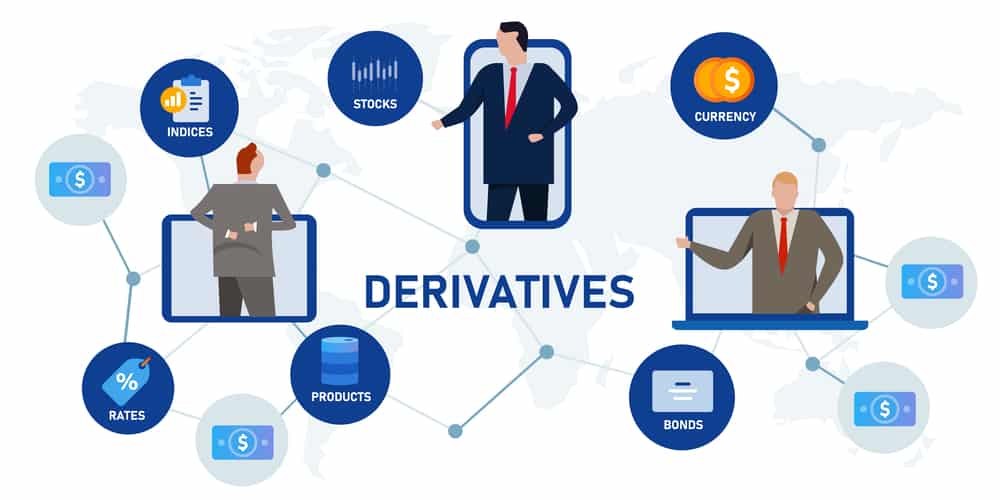FX derivatives are forward contracts for the purchase or sale of foreign currency, guided by a specified future timeline. They gain their value from fluctuations in the exchange rates of two or more currencies, and as such, they are classified as financial instruments.
These instruments are frequently used to hedge forex risk, as well as to speculate and arbitrage on currencies. When a security’s value is “derived,” it means that its value is dependent on the value of some other asset.
Types of forex derivatives
Foreign currency derivatives are divided into four main categories:
1. Forward contracts
Forward contracts are one of the oldest methods of hedging against foreign exchange risk. With this type of contract, money is not exchanged until a future date that has been mutually agreed upon by both parties is reached.
In this case, the exchange rate is set for the specific agreed date of transaction, regardless of the current market rate. Both sides must agree on the length of the agreement, which could be a single day or several weeks, or even years.
Let’s take an instance whereby a German exporter wants to sell their vehicles. They agree to sell 100 Mercedes Benzes to a US car dealer on the condition that the US car dealer pays the full amount within four months.
The car dealer agrees to pay the exporter in EUR, who will, in turn, convert the EUR to USD. To safeguard against the potential fluctuations in the EURUSD exchange rate, they may sign a forward contract.
2. Futures contracts
Futures contracts are agreements to purchase or sell a known amount of a currency at a predetermined price on a specific date in the future at a fixed price. At the end of the day, profits and losses from a future contract are evaluated and paid out. Foreign exchange futures contracts are typically traded in regular lots with predetermined maturity dates.
Interest rates are integrated, and they are typically valid for a period of approximately three months on average. In this regard, they are more inflexible than the forward contracts. Furthermore, because futures contracts are transacted every day through clearinghouses, they are a preferable option to forward because credit risk is eliminated.
The usage of these instruments is particularly favored by speculators seeking high returns on risky currencies by betting on the appreciation or weakening of a particular currency.
3. Options
When you buy or sell a currency option, you have the opportunity to do so at a specific price for as long as the option is valid. You can exercise your option at any time until the option expires. These types of derivatives come in two forms:
• A call option is a currency purchase option that gives the holder the right, but not the obligation, to buy a currency at a specific price.
• A put option is an FX currency trading tool in which you have the right but not obligation to sell a currency at a specific price.
Investors purchasing options (long positions) on currencies are expecting that the value of the currency will rise in the future, allowing them to purchase it at a lower price than it is now trading at. In contrast, a person selling an option anticipates a decline in the value of the currency, in order for the other entity in the contract to refrain from exercising their option on the market.
The seller charges the buyer a small transaction fee. The significant degree of flexibility that options provide makes them extremely attractive. In case the exchange rate becomes unsuitable to you, you can just opt-out. In that case, you will only incur a small loss in terms of the premium fees paid to the seller.
4. Swaps
A currency swap is a contract between two entities to exchange payment inflows in two different currencies but on different dates. Generally speaking, parties in such contracts trade the conditions of interest repayments applicable to the other entity in exchange for a currency equivalent.
Cross-currency swaps, in most cases, assist investors in obtaining favorable loans in international markets. As a result, interest rates are critical in this context. Investors exchange loan payments in one currency for an equivalent value in a different currency through the use of derivatives. In particular, banks and corporations engage in currency swaps in order to gain from reduced interest rates.
Let’s take an instance hereby an Australian company has landed a business deal in the UK and has to borrow 1 million GBP. However, the company is not comfortable with the high interest charged by UK banks.
However, an opportunity presents itself when it learns of another company seeking $1.4 million in loans from US banks. So the two parties get into a contract whereby the Australian business gets the 1 million GBP loan from the UK, and the American business gets $1.4 million from an American bank. They then swap the loans, and each company pays their loans.
In summary
As a result of the multiple benefits they bring to the financial markets, derivatives have had a huge impact on modern finance. However, it is also worth noting that they are used for speculative investment as well. Because of the inherently dangerous nature of derivatives, as well as their unpredictable behavior, excessive speculation may result in significant losses.
